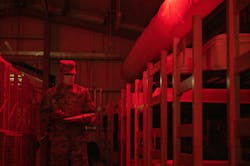Wanted: neuromodulation tech like near-infrared light and wearable devices to keep tired warfighters alert
ARLINGTON, Va. – U.S. military researchers are asking industry to find ways of keeping sleep-deprived warfighters awake and performing at top levels with only three hours of sleep or less each day.
Officials of the U.S. Defense Advanced Research Projects Agency (DARPA) in Arlington, Va., issued a broad agency announcement last Thursday (HR001125S0012) for the Reengineering Enabling Sleep Transitions in Operationally Restrictive Environments (RESTORE) project.
Controlling sleep
The RESTORE program aims to demonstrate precision control of sleep macro- and micro-architectures to optimize cognitive performance following a restriction to three hours of sleep each day, which is common during military combat operations.
Current civilian treatments seek to help those with sleep disorders achieve healthy, normative sleep by reducing time to sleep onset and awakenings during sleep, with a goal of achieving a fully restorative seven-to-eight-hour night sleep.
The workload of today's warfighter typically gives him less than three hours of sleep during combat, and less than six hours during regular duty.
The RESTORE project seeks advancements in non-invasive neuromodulation technologies to increase sleep efficiency to keep warfighters alert and maintain their cognitive performance under sleep-restricted conditions commonly faced by warfighters.
Sleepy warfighters
Over the past year, DARPA has shown other interest in helping sleepy warfighters to continue performing at high levels during combat. Last June DARPA issued a solicitation (DARPA-PS-24-17) for the initial phase-zero portion of the Alert WARfighter Enablement (AWARE) project.
AWARE seeks to develop a combination of drugs and electro-optical devices to help sleep-deprived warfighters stay alert without side-effects like anxiety, irritability, or euphoria.
This project aims at a combination of drugs and wearable devices that emit near-infrared light in the 750-to-900-nanometer bands to increase alertness non-invasively following sleep loss in humans, without negative side effects. No contracts for the AWARE program yet have been awarded.
Today's approaches for maintaining alertness following sleep loss include drugs like caffeine, and for U.S. military personnel undergoing long-duration training or missions, prescription stimulants like modafinil or dextroamphetamine.
The drug approach
Although dextroamphetamine is shown to be superior modafinil or caffeine at helping boost vigilance following sleep loss, it also can cause irritability, as well as and euphoria, which can lead to addiction.
Instead, AWARE seeks to develop a photoswitchable version of dextroamphetamine that is inactive except in the presence of near-infrared light, which activates it. Combining a photoswitchable drug and a near-infrared-emitting light could activate regions of the prefrontal cortex responsible for executive function, working memory, and decision making, while avoiding deep brain structures such as the amygdala and striatum, which have been implicated in mood alterations and euphoria.
Researchers want to develop AWARE technology with temporal selectivity to enable reversible activation of the drug precisely when needed. Moreover, temporal arrangement of near-infrared light pulses may titrate the drug dose over time to reduce the potential for addiction. Importantly, the temporal selectivity of switching the drug from an active to inactive state to make restorative sleep possible.
The combination of ingested photoswitchable drug and a near-infrared-emitting device selectively will activate neural pathways responsible for executive function, working memory, and decision making, to help keep fatigued warfighters alert wherever and whenever drug and light are present simultaneously.
Three-phase program
The AWARE program will have three phases over three years, and have two technical areas: developing photoswitchable dextroamphetamine (“PhotoDex”) molecules; and developing wearable transducers that emit near-infrared light.
A 15-month phase-zero; a nine-month phase two; and a 12-month phase three. AWARE phase zero has two technical areas -- one to develop and test a photoswitchable version of dextroamphetamine (“PhotoDex”) that can be reversibly activated by near-infrared light; and the other to develop near-infrared-emitting devices that non-invasively can go as deep as 1.5 centimeters with a resolution of 1 cubic millimeter.
Phase-one calls for combined TA1 and TA2 teams to perform behavioral assays in rodent models. Phase-two will conduct preclinical safety studies in preparation for human studies, integrate the near-infrared device for human use, and pursue regulatory approvals.
Companies interested should submit RESTORE abstracts no later than 14 April 2025, and full proposals no later than 18 June 2025 to the DARPA BAA Tool online at https://baa.darpa.mil.
Email questions or concerns to DARPA no later than 4 June 2025 to [email protected]. More information is online at https://sam.gov/opp/d005c5b47a5849d0a130a44e19f0bb86/view.
About the Author
John Keller
Editor-in-Chief
John Keller is the Editor-in-Chief, Military & Aerospace Electronics Magazine--provides extensive coverage and analysis of enabling electronics and optoelectronic technologies in military, space and commercial aviation applications. John has been a member of the Military & Aerospace Electronics staff since 1989 and chief editor since 1995.

